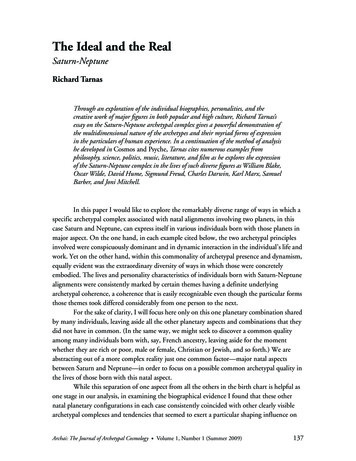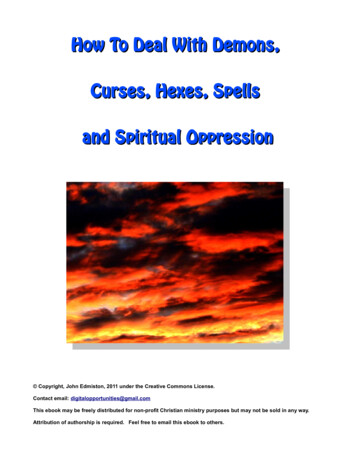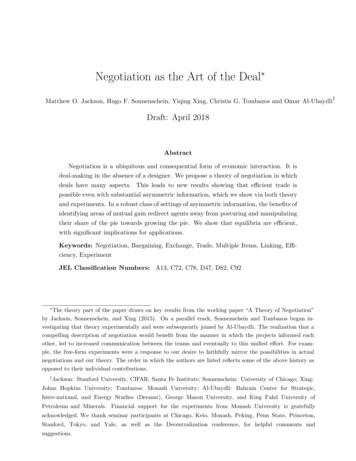
Transcription
The Ideal and the RealSaturn-NeptuneRichard TarnasThrough an exploration of the individual biographies, personalities, and thecreative work of major figures in both popular and high culture, Richard Tarnas’sessay on the Saturn-Neptune archetypal complex gives a powerful demonstration ofthe multidimensional nature of the archetypes and their myriad forms of expressionin the particulars of human experience. In a continuation of the method of analysishe developed in Cosmos and Psyche, Tarnas cites numerous examples fromphilosophy, science, politics, music, literature, and film as he explores the expressionof the Saturn-Neptune complex in the lives of such diverse figures as William Blake,Oscar Wilde, David Hume, Sigmund Freud, Charles Darwin, Karl Marx, SamuelBarber, and Joni Mitchell.In this paper I would like to explore the remarkably diverse range of ways in which aspecific archetypal complex associated with natal alignments involving two planets, in thiscase Saturn and Neptune, can express itself in various individuals born with those planets inmajor aspect. On the one hand, in each example cited below, the two archetypal principlesinvolved were conspicuously dominant and in dynamic interaction in the individual’s life andwork. Yet on the other hand, within this commonality of archetypal presence and dynamism,equally evident was the extraordinary diversity of ways in which those were concretelyembodied. The lives and personality characteristics of individuals born with Saturn-Neptunealignments were consistently marked by certain themes having a definite underlyingarchetypal coherence, a coherence that is easily recognizable even though the particular formsthose themes took differed considerably from one person to the next.For the sake of clarity, I will focus here only on this one planetary combination sharedby many individuals, leaving aside all the other planetary aspects and combinations that theydid not have in common. (In the same way, we might seek to discover a common qualityamong many individuals born with, say, French ancestry, leaving aside for the momentwhether they are rich or poor, male or female, Christian or Jewish, and so forth.) We areabstracting out of a more complex reality just one common factor—major natal aspectsbetween Saturn and Neptune—in order to focus on a possible common archetypal quality inthe lives of those born with this natal aspect.While this separation of one aspect from all the others in the birth chart is helpful asone stage in our analysis, in examining the biographical evidence I found that these othernatal planetary configurations in each case consistently coincided with other clearly visiblearchetypal complexes and tendencies that seemed to exert a particular shaping influence onArchai: The Journal of Archetypal Cosmology Volume 1, Number 1 (Summer 2009)137
The Ideal and the RealRichard Tarnashow the Saturn-Neptune complex was experienced and expressed in that individual’s life. Itwas only by taking into account the entire birth chart with all its planetary configurations thatI could glimpse something like the full richness of an individual’s life, work, and personalityas these embodied the complex interplay of the various archetypal principles involved.In the course of examining many hundreds of cases, I found that individuals born withalignments between Saturn and Neptune seemed to experience with special distinctness andpotency the tensions and contrasts between two radically different existential realms. On theone side, Saturn is associated with the principle of limit and finitude, the literal material andtemporal world of concrete empirical reality; with realism, hard fact, mortality, the dark andproblematic aspects of existence; with the impulse towards gravity, judgment, and discipline;with contraction, constriction, and endings; and with the establishing of strict boundaries,defined structures, and tense polarities. On the other side, associated with Neptune are thespiritual, ideal, and imaginative dimensions of life; the subtle, the intangible, and the invisible;the impulse to dissolve boundaries and structures in favor of underlying unities andundifferentiated wholes; and tendencies towards illusion, delusion, and escapism. In all of thefollowing examples, for further simplicity and clarity of analysis, we will consider only thosewith Saturn and Neptune in hard, quadrature aspect—conjunction, opposition, or square—sothat the dialectic between the two principles is especially vivid.As a simple first example of an individual born with Saturn and Neptune in closealignment, an opposition, we can recognize this particular archetypal polarity in the case ofWilliam Blake, with his well-known commitment to the life of the spiritual imagination insharp contrast to the narrowed vision of conventional perception and positivist science:May God keep us from single vision and Newton’s sleep!If the doors of perception were cleansed, everything would appear to man as itis, infinite. For man has closed himself up, till he sees all things throughnarrow chinks of his cavern.In every cry of every Man,In every infant’s cry of fear,In every voice, in every ban,The mind-forg’d manacles I hear.Art degraded, Imagination deniedWar govern’d the Nations.Archai: The Journal of Archetypal Cosmology Volume 1, Number 1 (Summer 2009)138
The Ideal and the RealRichard TarnasPoetry fetter’d Fetters the Human Race.Nations are Destroy’d or Flourish in proportion asTheir Poetry, Painting and Music are Destroy’d or Flourish:The primeval state of Man was Wisdom, Art and Science.1We can recognize this same archetypal polarity in a somewhat different form in the caseof Oscar Wilde, who was similarly born with Saturn and Neptune in close hard-aspectalignment (a square), and whose life and work consistently dramatized his heightened sensitivityto the tension between the aesthetic imagination and the drab assaults of ordinary life:It is through Art, and through Art only, that we can realize our perfection;through Art and Art only that we can shield ourselves from the sordid perils ofactual existence.2So also, to take a more contemporary example, James Hillman, was born with Saturn andNeptune in close square alignment. Here the archetypal polarity is visible in Hillman’s sustainedexploration of the contrast between, on the one side, the tyrannical constrictions of the modernmind with its literalism and shallow vision, and on the other, the soul-making depths of the imaginative and aesthetic sensibility found in the ancients, the Renaissance, and Romanticism. Thushis thesis of the “poetic basis of mind” (first set forth in his famous Terry Lectures at Yale University in 1972, when Saturn and Neptune were in close opposition in the sky) asserted that a truepsychology “starts neither in the physiology of the brain, the structure of language, the organization of society, nor the analysis of behavior, but in the processes of imagination.”Where there is a connection to soul, there is psychology; where not, what istaking place is better called statistics, physical anthropology, culturaljournalism, or animal breeding.31. These quotations are from The Poetry and Prose of William Blake, ed. D. V. Erdman, commentary by H. Bloom(New York: Doubleday, 1970). In the following, page numbers refer to this publication:“and Newton’s sleep”: William Blake, “Letter to Thomas Butts, 22 November 1802,” 693.“narrow chinks of his cavern”: Blake, The Marriage of Heaven and Hell (1793), 39.“mind-forg’d manacles I hear”: Blake, “London,” Songs of Experience (1794), 27.“War Governed the Nations”: Blake, The Laocoön (1820), 271.“Wisdom, Art and Science”: Blake, Jerusalem (1804), 144.Blake was born with Mars conjoined to his Neptune opposite Saturn, visible in the highly embattled character ofhis assertion of the spiritual imagination over the literal, disenchanted, mechanistic vision.2. Oscar Wilde, The Critic as Artist (1891; repr., New York: Mondial, 2007), 67.3. James Hillman, Re-Visioning Psychology (1975; repr., New York: HarperPerennial, 1992), xviii–xix. Hillmanalso cites this definition of the poetic basis of mind in Archetypal Psychology: A Brief Account (Dallas: Spring Publications, 1983), 10.Archai: The Journal of Archetypal Cosmology Volume 1, Number 1 (Summer 2009)139
The Ideal and the RealRichard TarnasEach of these several statements by Blake, Wilde, and Hillman are representative, andeven fundamental, expressions of their particular sensibilities and intellectual vision. Eachstatement also clearly reflects the basic polarity between the two archetypal principlesassociated with Saturn and Neptune. In a sense, this particular planetary combination isespecially instructive as an example of how the two corresponding archetypes might combine,because these particular archetypes are of such radically different natures. Their veryontologies are, so to speak, from different planets—matter versus spirit, the concretelyempirical and literal versus the imaginative and the ideal, the finite and temporal versus theinfinite and eternal. Yet the form this archetypal polarity took in Blake, Wilde, and Hillman,though highly characteristic of many individuals born with these two planets in aspect, wasonly one of several such forms I observed in which the polarity was expressed. An equallycharacteristic motif among individuals born with this same planetary configuration—andequally reflective of this same archetypal polarity—was a definite tendency towardsmetaphysical skepticism, a seemingly innate proclivity to doubt the existence of transcendentor spiritual realities (Neptune), negating these in favor of the concrete empirical world(Saturn). This tendency often took the form of a strong impulse to demystify religious beliefas itself a principal cause of both oppression and illusion in human life.For example, David Hume, the paradigmatic skeptic of modern philosophy and acutecritic of religious belief (On Miracles, Dialogues on Natural Religion) was born with Saturn andNeptune in alignment, as also was Bertrand Russell, his twentieth-century successor (Why I AmNot a Christian). So also was Freud, with his psychoanalytic deconstruction of religious belief—most explicit in The Future of an Illusion in which all religion is viewed as the psychological residue of childhood projections of parental omnipotence. So too were Darwin, with his scientificdismantling of the biblical understanding of creation, and Marx with his socioeconomic deconstruction of religion (“the opiate of the people”), and also Foucault with his postmodern development of the same tendencies—all born with Saturn and Neptune in alignment.In the latter group of individuals, the tension between the two correspondingarchetypal principles seemed to be resolved through a decisive identification with one side ofthe polarity (Saturn) in such a way as to require the negation of the other (Neptune). Thearchetype associated with Saturn, governing the concretely literal and material dimensions oflife, as well as the very impulse towards judgment and negation, is here expressed as acommitment to a skeptical common-sense empiricism, strict factual judgment, a fidelity tothe demands of the temporal and finite—the naked truth undistorted by emotion or fantasy,a stern negation of whatever is assessed and found wanting. This Saturnian constellation ofimpulses is expressed as an emphatic denial of the entire archetypal gestalt associated withNeptune—the metaphysical, the spiritual, the supernatural, the transcendent, the timelessand infinite—with these here regarded as naïve illusion and wishful projection, the shadowside of the Neptune principle.Archai: The Journal of Archetypal Cosmology Volume 1, Number 1 (Summer 2009)140
The Ideal and the RealRichard TarnasNegating the spiritual: Freud, Marx, and Darwin,each born during a Saturn-Neptune alignmentThis same theme and archetypal complex was evident in major cultural figures fromearlier centuries, but took a modified form according to the cultural climate of the particularera. The Saturn-Neptune conjunction takes place every thirty-five to thirty-seven years,occurring approximately three times each century. The births of Bacon and Descartes, forexample, took place in coincidence with two successive Saturn-Neptune conjunctions thirtyfive years apart, in 1561 and 1596, respectively, at the end of each conjunction period.4 Inboth cases, we see the characteristic themes of this archetypal complex that we observed in thecases of Hume, Russell, Freud, and others. In the case of Bacon, we see the shrewd skepticalcritiques of conventional beliefs, the call for tough-minded empirical rigor against thespeculations of the ancients and the Scholastics, the demand for practical scientific resultsrather than metaphysical imaginings, the constant impulse to unmask illusions and naïveprojections. This unmasking impulse was precisely expressed in Bacon’s famous analysis of the“idols” (“idols of the tribe,” “idols of the cave,” and so forth), revealing the manifold ways thehuman mind can fail through prejudice and ingrained habit, linguistic confusion, perceptualdistortions, and the like. Yet all these Baconian themes suggestive of disenchantment anddemystification were expressed within an emphatically Christian framework, in which whatwas questioned was not traditional religious faith, but rather philosophical positions thatBacon viewed as empirically untenable, mere fantasies of benighted tradition, resulting from anundisciplined mind prey to the distortions of the imagination.In the case of Descartes, born during the Saturn-Neptune conjunction exactly onecycle after Bacon, the same archetypal complex was evident, again expressed within the earlymodern accommodation between science and religion, but this time with a rationalist ratherthan empiricist outcome. We see the familiar themes of the Saturn-Neptune polarity inDescartes’s initial philosophical
The Ideal and the Real Richard Tarnas Poetry fetterÕd Fetters the Human Race. Nations are DestroyÕd or Flourish in proportion as Their Poetry, Painting and Music are DestroyÕd or Flourish: The primeval state of Man was Wisdom, Art and Science. 1 W e can recognize this sam e archetypal polarity in a som ew hat different form in the case











